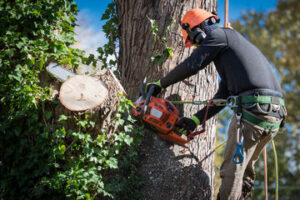Trees add beauty and value to any property, but they require regular care to thrive. Without proper maintenance, trees become damaged and may pose a hazard to people or structures on the property.

Tree Service La Jolla is licensed and insured to offer a full suite of specialized equipment for safe and efficient maintenance. Look for punctuality, scheduling convenience, and thorough cleanup after service as indicators of a trustworthy provider.
A well-manicured landscape has the ability to greatly enhance a property’s beauty. This is why pruning services are so important. While some people may be tempted to handle the trimming of their own trees and shrubs, it is crucial to leave these tasks in the hands of professional Arborists who have the experience, equipment, and knowledge to ensure that your trees remain healthy and structurally sound.
When pruning is done incorrectly, it can result in irreversible damage and even death to the plant. To avoid this, our skilled Arborists utilize the most up-to-date pruning techniques and a working knowledge of tree biology and growth patterns.
Unlike gardens, which can be left largely untended, trees and shrubs need regular pruning to keep them looking their best and functioning at their full potential. The proper timing of pruning depends on the species and should be carefully considered for each individual site.
Proper pruning can prevent the spread of disease and decay to other branches, reduce wind resistance, and promote good air movement throughout the crown. It also helps control light penetration and manage growth, as well as maintain a desired aesthetic appearance.
We provide a variety of tree pruning and trimming services that can be customized to meet your specific needs. Our skilled Arborists are capable of removing dead or damaged wood, thinning the canopy to increase light penetration, raising the height of trees, and reducing the size of large trees by cutting back the branch terminals.
Some trees and shrubs require special care to maintain their appearance, such as flowering azaleas, lilacs, gardenias, and rhododendrons. These plants flower on wood that was produced the previous season, so it is essential that they be pruned immediately after their blooming cycle in the spring.
In the case of trees, we prune to remove dead or dying limbs that could fall and damage your home, cars, or pedestrians, as well as obstruct views. Additionally, we remove suckers that form at the base of the trunk or stalk, water sprouts that grow straight up from the main branches, and rubbing or crossing branches.
Removal
Whether it’s due to storm damage, age-related weakness, or other reasons, trees sometimes need to be removed. A professional tree service will evaluate a potential problem and find the best solution to keep your property safe and beautiful.
Some of the most common removal services include:
Branches that have grown too close to power lines, buildings, or other structures should be trimmed to prevent damage and potential fire hazards. Stumps can be a tripping hazard or attract pests, so it’s important to have them ground down or removed altogether. Professionals have specialized equipment that they use to grind and remove stumps safely.
Overgrown bushes and other plants may need to be removed to allow more sunlight to reach other landscaping features and reduce energy costs. Additionally, certain trees produce pollen or other substances that cause allergies in people and need to be removed.
Dead or dying trees pose a major safety risk because they are likely to fall during a storm, creating property damage and possibly endangering people. They may also become a home for termites, which can damage property and contaminate the surrounding environment.
Land clearing is often a necessary part of a construction project, including building a new house or expanding a driveway. Professionals have specialized equipment to safely clear large areas with minimal impact on the surrounding landscape and property.
A messy yard can decrease the value of a home, so hiring professionals to trim and remove trees is a great way to maintain the beauty of your property. In addition to keeping your yard looking pristine, this service can increase the value of your home by making it more appealing to prospective buyers. Contact a professional tree service today to schedule a consultation and get started!
Stump Grinding
Tree stumps are unsightly, detract from the overall beauty of your yard and can even contribute to pest and disease problems. Whether you have a single stump or several, the experts are equipped to grind your stumps out safely and effectively. Stump grinding is an essential service for any home or commercial property owner. It can be difficult to do on your own, as it requires specialized equipment and knowledge of proper techniques. It is also crucial to remove the entire stump and roots to prevent future problems like fungal infections or root rot, as well as potential damage to underground utilities such as gas lines, sewers and water systems.
Stump grinding is done by using a piece of specialized equipment that cuts the top of the stump and grinds the rest of it down into wood chips, which can then be used as mulch. This method is less expensive than full stump removal, as it does not require digging up the entire stump and its roots. It is also more environmentally friendly than stump removal, as the ground below the stump can be left undisturbed.
After the stump is ground, it can be filled with dirt or a new tree can be planted in the spot. However, it is important to note that the location of a new tree must be able to support its weight without being too close to the remaining stump. Leaving a stump in the ground will cause it to grow roots and compete with the new planting, potentially leading to suffocation and root rot.
If a stump is allowed to rot, it can create a tripping hazard for anyone who walks on the property and may attract pests such as termites or carpenter ants. Stumps also hinder lawn care by getting in the way of mowing and other landscaping activities. Stump grinding will make the area easier to maintain, eliminating tripping hazards and allowing you to enjoy your yard again.
In addition, rotting stumps can create a fire risk, as the flammable material is exposed and ready to burn. Tree Service LLC provides safe and effective stump grinding services to homes and businesses, helping homeowners and business owners get their yards back and keep them looking their best.
Emergency Services
Even with the best of care, sometimes trees can become unstable and fall or pose a risk to people, cars or other structures on your property. If you have a tree on your property that has fallen or is showing signs of being hazardous, you need a 24-hour emergency tree service company to come out and assess the situation. These services are designed to address immediate concerns caused by storm damage, disease, pest infestation, and other factors.
Some common signs that you need emergency tree services are hanging branches, cracking or breaking, and a hollow trunk. A cracked or broken branch could fall without warning, causing damage to your property. Dead or dying branches are also dangerous and may need to be removed. If a tree is leaning, it indicates a structural problem and can be a safety hazard for you, your family, or neighbors.
Other reasons to consider emergency tree service include:
Emergency services can help keep you and your family safe by removing damaged or hazardous trees before they cause further damage. They can also help reduce property damage and improve the overall appearance of your landscape. In addition, prompt removal of a damaged tree can assist with insurance claims related to property damage.


